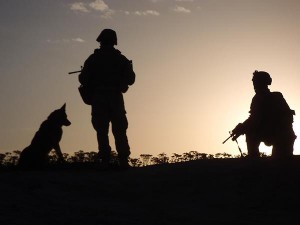Honoring our Human and Canine Veterans

For our heroes, both 2- and 4-legged. Photo courtesy of A. Uribe and "Support Police K9s and MWDs" (www.facebook.com/SupportPoliceK9sandMWDs).
On this Veterans’ Day, we would like to thank and honor our servicemen and servicewomen for their duty, dedication, and service to our country; thank you for the tremendous sacrifices you have made! We also want to thank all the hard-working canine veterans that have worked tirelessly alongside their handlers to sniff out explosives, protect their units, alert on hidden enemies, guard their handlers, and take down the bad guys. Our military’s increased reliance on these dogs has helped saved countless lives while in battle and while in enemy territory.
Brief History of the US Military Dog
Military Working Dogs (MWDs) gained much attention after a Belgian Malinois named Cairo participated in the SEAL Team 6 mission that resulted in Osama bin Laden’s death. However, MWDs have been used regularly by American military since World War II, with the legacy of war dogs extending back even further to ancient Rome, ancient Greece, and ancient Persia.
American servicemen returning from the front during World War I brought with them tales of the heroic German Shepherd Dogs employed by the German military. These dogs served as sentry dogs, as messenger dogs, and as ambulance dogs trained to locate wounded soldiers on the battlefield. During World War II, several efforts were made by U.S. Military to use dogs as sentry dogs, scout dogs, messenger dogs, and sled dogs. By 1942, several training centers were established in the U.S., taking on the tasks of procuring, training, and preparing dogs for military use. The predominant breeds used for this work were German Shepherd Dogs, Belgian Sheepdogs, Doberman Pinschers, farm collies, Siberian Huskies, Malamutes, Eskimo Dogs, and crosses of these breeds.
While the war dog program initially experienced difficulty and some negative results during WWII, the positive effects of MWDs outweighed the bad, and the program continued despite facing a reduction in the number of dogs. Dogs continued to be used through the Korean War, and were then utilized more heavily during the Vietnam War. By this point in time the dog of choice was the German Shepherd Dog, with most of the MWDs serving as sentry dogs. Over 3,747 dogs were used in Vietnam; sadly, only 204 dogs exited Vietnam over the 10-year period of war. It is estimated that these dogs and their handlers saved over 10,000 lives.
Currently, more than 3,000 MWDs can be found around the world serving in all branches of the U.S. Military, with over 600 of these dogs serving in Afghanistan and Iraq. Belgian Malinois and Labrador Retrievers have become more popular, often outnumbering the German Shepherd Dogs. Many of these dogs serve as explosives dogs, trained to detect a variety of IEDs or other explosive devices. Other roles for today’s MWDs include patrol dogs, sentry dogs, combat tracker dogs, narcotics dogs, and more. These MWDs have saved thousands of lives.
For more information on Military Working Dogs and their handlers, please visit the website for the US War Dog Association.

